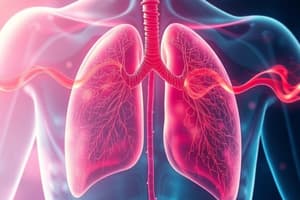Podcast
Questions and Answers
What process occurs in the alveoli of the lungs?
What process occurs in the alveoli of the lungs?
- Tissue respiration
- Cellular respiration
- Internal respiration
- External respiration (correct)
Hypoxia refers to inadequate blood oxygenation.
Hypoxia refers to inadequate blood oxygenation.
False (B)
Name one physiological factor that affects oxygenation.
Name one physiological factor that affects oxygenation.
Increased metabolic rate
During ___________, alveolar ventilation is inadequate to meet the body's oxygen demand.
During ___________, alveolar ventilation is inadequate to meet the body's oxygen demand.
Match the following respiratory alterations with their definitions:
Match the following respiratory alterations with their definitions:
Which lifestyle risk factor is NOT mentioned as affecting oxygenation?
Which lifestyle risk factor is NOT mentioned as affecting oxygenation?
What is the primary function of the respiratory system?
What is the primary function of the respiratory system?
Administration of humidified air is a nursing intervention for airway management.
Administration of humidified air is a nursing intervention for airway management.
What should a nurse monitor to assess respiratory status?
What should a nurse monitor to assess respiratory status?
Respiration occurs only during inhalation.
Respiration occurs only during inhalation.
Cyanosis is a late sign of __________.
Cyanosis is a late sign of __________.
What is the process of gas exchange called?
What is the process of gas exchange called?
What does the term 'dyspnea' describe?
What does the term 'dyspnea' describe?
The expansion of the chest cavity during inhalation creates _______ pressure inside the lungs.
The expansion of the chest cavity during inhalation creates _______ pressure inside the lungs.
Match the following terms with their definitions:
Match the following terms with their definitions:
What happens during exhalation?
What happens during exhalation?
Oxygen is not essential for human survival.
Oxygen is not essential for human survival.
What is the significance of a properly functioning alveolar system?
What is the significance of a properly functioning alveolar system?
The respiratory process involves both _______ and oxygenation.
The respiratory process involves both _______ and oxygenation.
Which of the following is NOT a factor that affects gas exchange in the alveoli?
Which of the following is NOT a factor that affects gas exchange in the alveoli?
Flashcards
Exchange of Respiratory Gases
Exchange of Respiratory Gases
The process of oxygenating the blood and eliminating carbon dioxide from the body, primarily in the lungs.
External Respiration
External Respiration
The movement of gases between the alveoli in the lungs and the blood.
Internal Respiration
Internal Respiration
The movement of gases between the blood and the body cells.
Hyperventilation
Hyperventilation
Signup and view all the flashcards
Hypoventilation
Hypoventilation
Signup and view all the flashcards
Hypoxia
Hypoxia
Signup and view all the flashcards
Hypoxemia
Hypoxemia
Signup and view all the flashcards
Tachypnea
Tachypnea
Signup and view all the flashcards
Bradypnea
Bradypnea
Signup and view all the flashcards
Apnea
Apnea
Signup and view all the flashcards
Respiration
Respiration
Signup and view all the flashcards
Inhalation (Inspiration)
Inhalation (Inspiration)
Signup and view all the flashcards
Exhalation (Expiration)
Exhalation (Expiration)
Signup and view all the flashcards
Ventilation
Ventilation
Signup and view all the flashcards
Perfusion
Perfusion
Signup and view all the flashcards
Diffusion
Diffusion
Signup and view all the flashcards
Oxygenation
Oxygenation
Signup and view all the flashcards
Oxygen
Oxygen
Signup and view all the flashcards
Gaseous Exchange
Gaseous Exchange
Signup and view all the flashcards
Respiratory System Function
Respiratory System Function
Signup and view all the flashcards
Study Notes
Oxygenation
- Oxygen is vital for survival, essential for cellular function
- The respiratory system delivers oxygen and removes carbon dioxide
- Normal oxygenation involves proper ventilation and circulation
- Oxygenation refers to how effectively tissues receive oxygen
Normal Oxygenation Process
- Inspired air enters the lungs
- Oxygen moves from alveoli to the blood (pulmonary capillaries)
- Carbon dioxide moves from blood to alveoli
- Oxygenated blood circulates to tissues
- Cells use oxygen; carbon dioxide is released
Physiology of Respiration
- Ventilation ensures air movement in and out of lungs
- Oxygenation is crucial for cells receiving oxygen
- Gas exchange in alveoli depends on factors like:
- Airway integrity
- Functional alveolar system
Mechanism of Ventilation
- Inhalation: Chest cavity expands, reducing pressure, drawing air in
- Exhalation: Diaphragm and intercostal muscles relax, increasing pressure, forcing air out
Process of Oxygenation
- Ventilation: Moving air into and out of lungs
- Perfusion: Cardiovascular system transporting oxygenated blood to tissues
- Diffusion: Exchange of gaseous substances in alveoli and capillaries (external respiration)
- External Respiration: Exchange in alveoli
- Internal Respiration: Exchange in capillaries and tissues
Factors Affecting Oxygenation
- Physiological factors (e.g., metabolic rate)
- Disease processes (e.g., anemia, dehydration)
- Environmental factors (e.g., high altitudes)
- Factors affecting chest wall movement (e.g., trauma)
- Pregnancy
- Musculoskeletal abnormalities
- Medications
- Lifestyle factors (e.g., smoking)
Common Respiratory Alterations
- Hyperventilation: Increased breathing rate and depth
- Hypoventilation: Inadequate breathing rate and depth
- Hypoxia: Inadequate tissue oxygenation
- Hypoxemia: Inadequate blood oxygenation
- Altered breathing patterns (e.g., tachypnea, bradypnea, apnea)
- Obstructed airways
Nursing Interventions
- Airway management: Humidified air or immediate oxygen administration; monitoring
- Monitor respiratory status and oxygenation
- Administering medications (e.g., bronchodilators )
- Auscultate lungs for sounds (before and after treatment)
- Encourage deep breathing, coughing
Respiratory Monitoring
- Observe rate, rhythm, depth and effort of breathing
- Monitor changes in oxygen saturation and arterial blood gas values
- Note any restlessness, anxiety, or air hunger
Anxiety Reduction
- Calming and reassuring behaviors
- Staying with the patient
- Encouraging slow breathing techniques (e.g., pursed lips)
Teaching
- Patient education about the disease process and medication
- Preventing adverse effects of treatment
- Evaluate patient's medication self-administration skills
- Involve family/significant others in the process
Studying That Suits You
Use AI to generate personalized quizzes and flashcards to suit your learning preferences.




